Smart Home Solar Energy Project

Our home is located in Suffolk (East Anglia, UK), one of the sunniest and driest parts of the UK. Our house faces 154° South (i.e. 26° to the East of South) and the roof is inclined at 40°. This means it is pretty much ideally orientated for solar PV energy collection according to this orientation calculator. From what I've seen so far, the right roof orientation makes a big difference.
Energy costs rose significantly in 2022 and the lack of a credible energy strategy from our UK government will ensure that prices only rise further. It made good financial sense to install solar panels and battery storage, especially as we had plans to get an electric car, install air conditioning and possibly a hot tub later. Our planned installation will also provide us with a high degree of protection from the UK power network, which is under increasing pressure. This project is basically future-proofing our home, whilst saving us a lot of money.
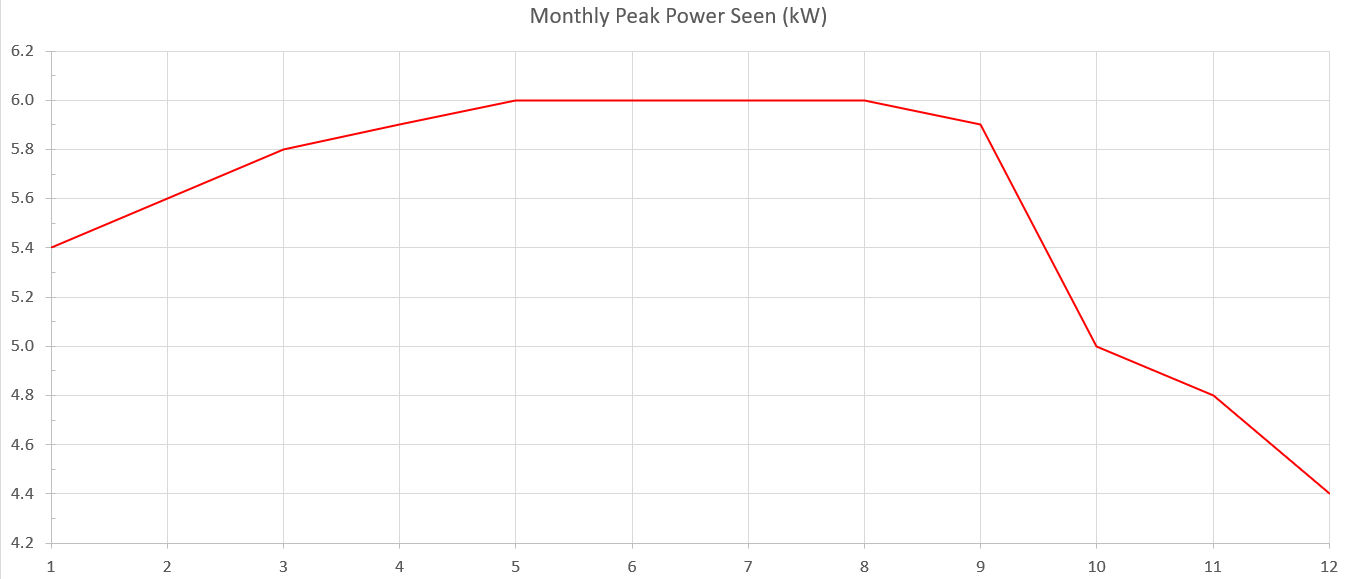
I am doing detailed energy analysis of how this project is performing. A few interesting statistics from my solar installation so far are:
- I have yet to experience a day where we have generated no solar energy at all. The lowest was 0.2kWh on 4th December 2022.
- The worst month for solar energy generation has been November 2022 with 255kWh, an average of 8.2kWh per day.
- The best day so far was 26th May 2023 at 46.4kWh.
- My best weekly generation so far has been 266.1kWh, from 12th to 18th June 2023, a daily average of 38.0kWh.
- My best monthly generation so far has been 1013kWh in June 2023, a daily average of 33.8kWh.
- On a sunny day, very close to the shortest day of the year (21st December 2022), peak solar power was 4.3kW and we generated 21kWh.
- On the 18th May 2023 we exported 39.2kWh (of the 43.1kWh generated) and earnt £9.48 on the Octopus Flux tariff.
Requirements
The requirements for any solar installation should be based around your typical energy usage over a year but, also factor in monthly variations. You also need to future-proof it and think about what else you might be using the generated energy for. I've documented the background to my project in more detail. My basic requirements are:
- To install as many PV panels on our roof of our home as possible, since the size of our roof is the limiting factor.
- To include battery storage to enable our home to run from battery power alone through the night and to also work during mains power outages. The usable battery capacity is about the most our home uses in a day.
- A smart electric vehicle charger, to enable us to charge an EV using spare/free solar power only and cheap rate electricity when available.
- Some spare capacity for our future plans to install a hot tub, air-conditioning and smart electric hot water heating.
- To help us improve our energy security.
Solar Panels
Typically, solar panels are mounted on frames on top of the existing roof tiles. In some cases, the tiles are removed, to allow the panels to be mounted flush into the roof. A third option is to use solar panels that look like roof tiles.
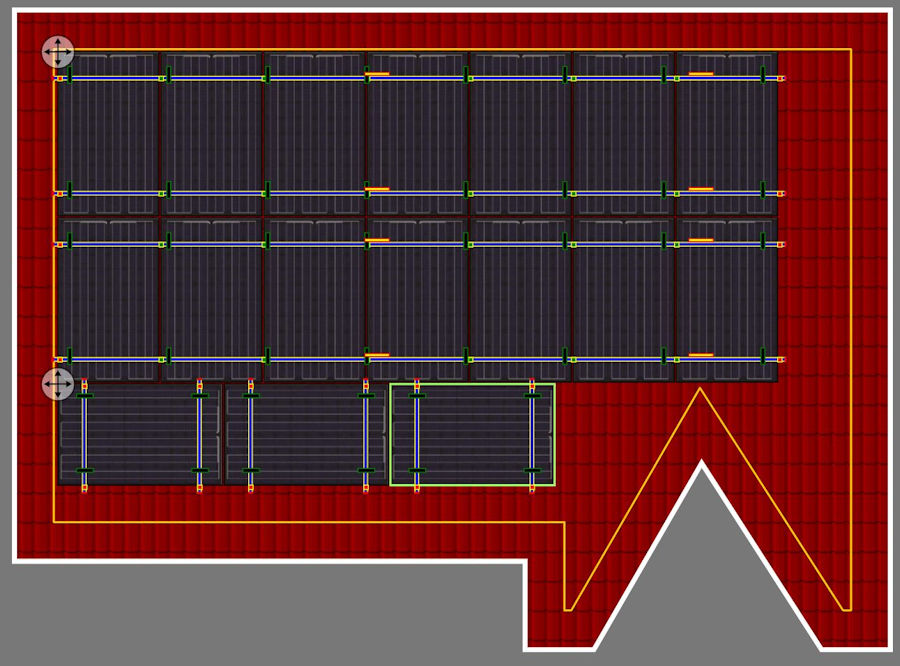
Our roof is about 9 meters across and tall enough to allow more than 2 rows of panels. This is the layout of the installed panels. As well as being well orientated, there is no shading on any of our panels. I also requested that the panels were installed with protective bird mesh.
Monitoring
It is essential that my solar installation provides a computer interface, to enable my contextual smart home to access key data in real-time. This is so that it can make intelligent decisions about what is powered and when. This is includes things like:
- The state of mains power connection.
- The power being generated by our solar panels.
- The battery charge state.
- The current whole house power usage.
- The amount of power being imported.
- The amount of power being exported.
I also need to be able to monitor external loads such as electric car charge state, hot tub temperature, etc.

My @smartest_home sometime tweets about Solar Power.
Control
I want my contextual smart home to be able to decide the optimum time to charge our CUPRA Born, divert power to a hot tub and to be able to divert power to our smart immersion heater controller. It will also control when the air conditioning is enabled.
Selecting An Installer
This is a really important element of any solar project, so I have written a page dedicated to selecting an installer.
Quality Of Life
All of the things I do in my contextual smart home aim to improve our quality of life. It is the key test I use before I install any technology, though sometimes I do test new features to confirm this assumption. This project is no exception. It will improve our quality of life in the following ways, above and beyond the significant things my contextual smart home is already doing for us. These are things we would not have done without our solar energy installation:
- It will ensure our existing smart home runs during power outages and provides all of its many features and user interfaces with exceptional reliability. The core features of my Home Control System are already powered via a 12V dc UPS and will continue to be so.
- It will allow us to always have a charged electric vehicle available for use (with zero charging cost).
- It will allow us to use electricity to pre-heat our hot water tank and ensure we always have hot water available (with zero cost and also reducing our gas bill).
- It will allow us to install smart air conditioning to keep our home comfortable during the hottest summer days (with zero running costs).
- It will allow us to run the dehumidifier in our conservatory, to keep the space comfortable (with zero running costs).
- It will allow us to run smart electric towel rails, to ensure we have warm & dry towels when required (with zero running costs).
- It will allow us to run a second freezer for food and a dedicated drinks fridge (with zero running costs).
- It will allow us to install a hot tub in our garden and run it (with zero heating costs).
- It will allow us to run a dedicated ice machine during the summer (with zero running costs).
- It will provide protection from failures and limitations of the UK power network.
- On cold days we can pre-condition the CUPRA Born using the app, to have a defrosted and warm car waiting for us.
- We have the freedom to do baking, cooking and run appliances like the tumble dryer whenever we want.
Return On Investment
Based on electricity prices as of today (June 2022), the payback period (based on our current usage) is about 11 years. If you factor in planned increases the payback period falls to 8 years. It is very likely that prices will rise again soon. These projections don't factor in the value added to our property. As a home that will essentially cut our electricity bill by 91% and will work through power cuts the value has increased but, maybe not by a huge amount.
Distribution Network Operator
Your Distribution Network Operator (DNO) is the company that owns and operates the power lines and infrastructure that connect the national grid network to your property. In order to export power back into the network approval is required from your DNO. The installation must be completed by a Microgeneration Certification Scheme (MCS) approved installer.
You can find out who your DNO is by completing this simple form (it just requires your postcode). My electricity network operator is UK Power Networks and my gas network operator is Cadent.
There are basically two types of approval for consumer solar installations:
- G98 is a simple connection procedure for Fully Type Tested systems under 16A per phase, systems are installed on an install and inform basis. If the Micro-Generator to be connected is installed in compliance with G98. The DNO can be notified of the installation under G98, up to 28 days after the commissioning date.
- If you are installing a large scale solar system (greater than 16A per phase), you will need to apply for G99 DNO approval prior to installation. This is because the grid needs to determine whether your local distributor can handle the extra load. The process of the DNO reviewing your application can take between 8 to 12 weeks.
Your DNO may also place a G100 export limitation on your installation, which limits the maximum power you can export into the network. In my case it matches the 6.63kW peak output of my solar panels. I don't know how this is enforced yet. I'm guessing it will be a configurable setting of the Tesla Backup Gateway.
Energy Provider
With solar installations, it isn't just about getting paid as much as you can for the energy you generate/export. This is especially true with this project, as I am trying to minimise the amount we export by using our generated power as intelligently as possible. Energy providers may offer you a good export rate but, then hit you with a very high import rate. All energy providers have a daily 'standing charge', which may be significant.
I'm currently with Octopus Energy and plan to stay with them. Their service has been excellent over the years, they are generally very good at clearly communicating things and also responsive to new requests. They also offer a wide range of tariffs and some good rates for exported energy.
Energy Tariffs
Although I expect it to be a small part of our Return On Investment (ROI), being paid for electricity we generate and export is part of my plan. Being on the right energy tariff at the right time is so important that I cover it on a separate tariff page.
Smart Meter
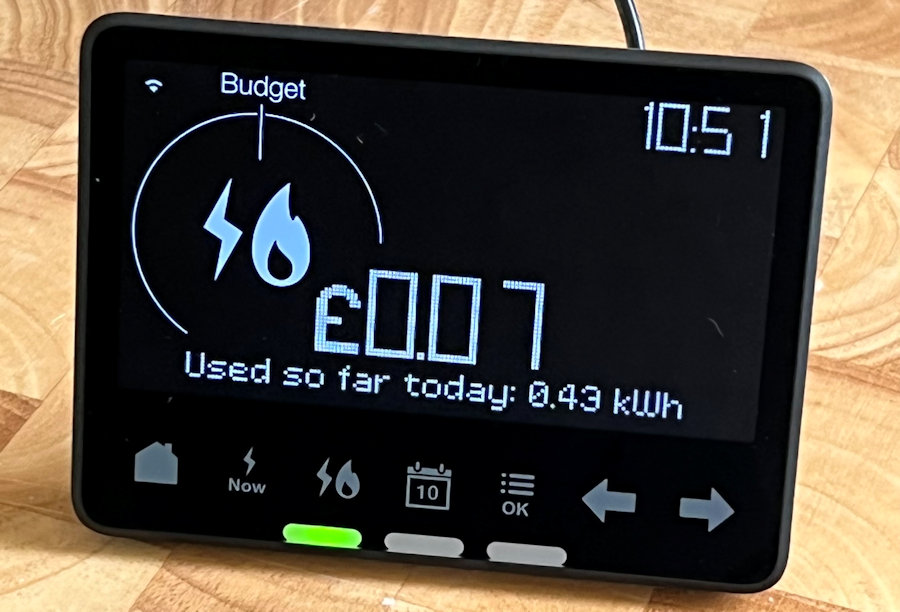
You can read all about the smart meter installation and my review.
Safety
One of the key things our contextual smart home does is improve our safety. I already have an Arduino in my garage interfacing a number of sensors to it:
- Garage Door - a smart door contact sensor
- Garage Humidity - a smart humidity sensor
- Garage PIR - a smart PIR sensor
- Garage Smoke Alarm - a smart smoke sensor
- Garage Temperature - a smart temperature sensor
Each of these sensors can easily be configured to trigger our smart alarm if required. Minimum and maximum values can easily be set for all temperature and humidity sensors. In addition to these, I may add more temperature sensors on the Tesla Powerwall and Tesla Backup Gateway.

My @smartest_home occasionally tweets in real time about the garage sensors. This one was from 18th July 2022, one of the hottest days ever in the UK. The garage temperature is usually much lower than this and never drops below 10°C.
Installation
Ensuite Extractor Fan Vent
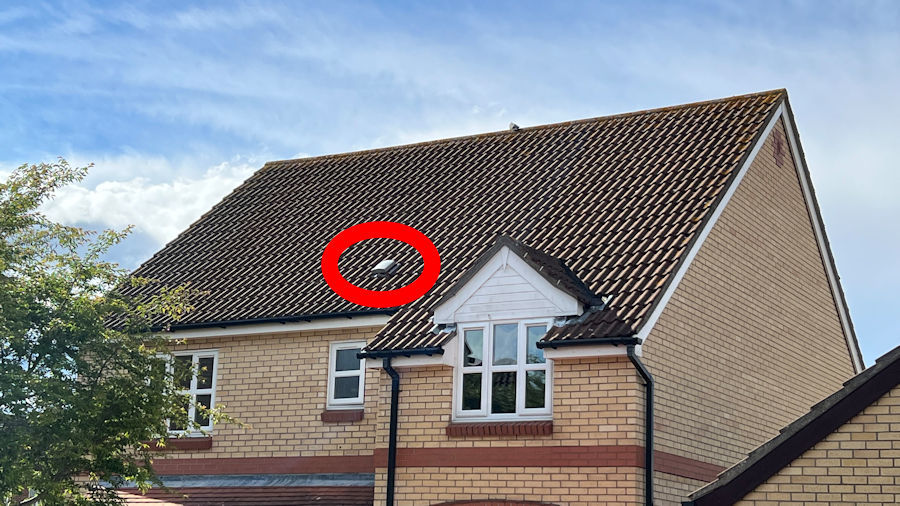
Before the solar panels are installed, there was a bathroom extractor vent sticking out of the roof which needed to be replaced by a low profile vent, as this will be underneath the solar panels and mounting frame.
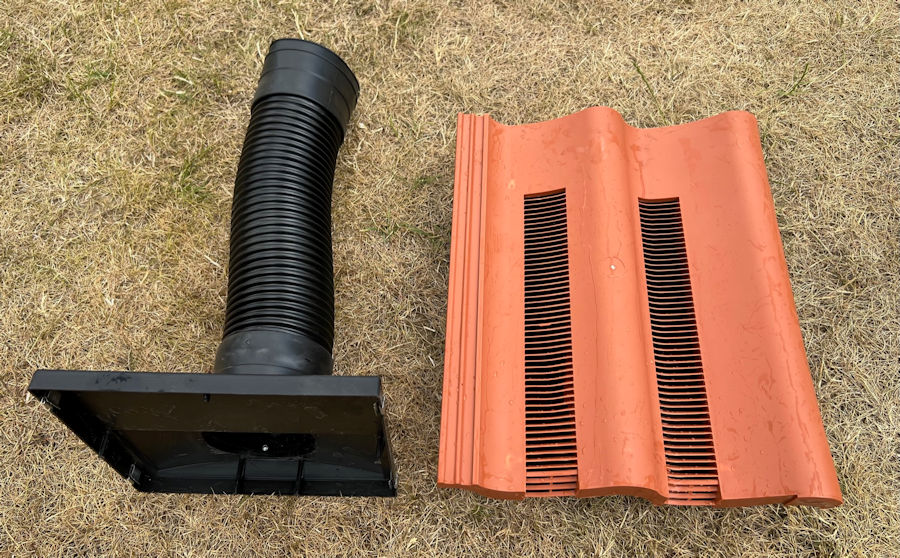
This is the tile vent that replaced it. Whilst replacing this, I'm also replacing the current ceiling mounted extractor fan with a more powerful in-line fan, which is also quieter. This will be under smart control to improve its operation and our quality of life. You can read more about my smart extractor fan control.
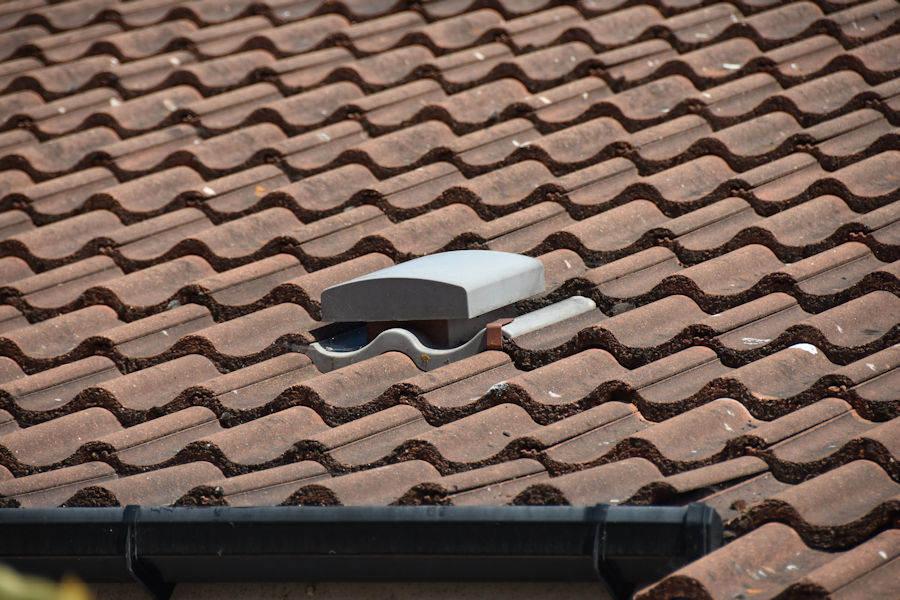
This is what the old roof vent, looked like. I know little about roofing, so I paid a professional to take this out and fit the new one. In retrospect, I should have let them supply the vent as well because I bought the wrong one initially.
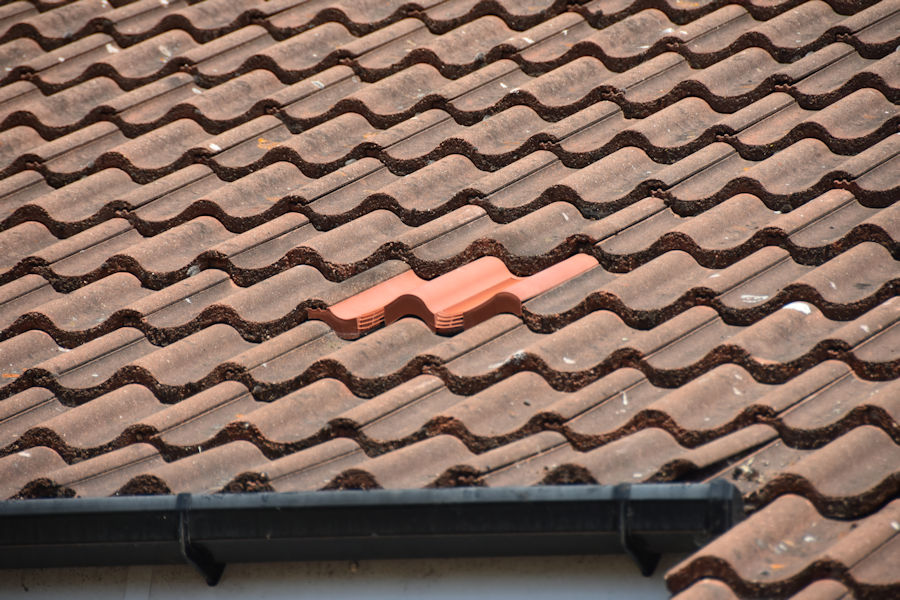
This is the new roof vent, which now sits flush with the existing roof.
Solar Panels
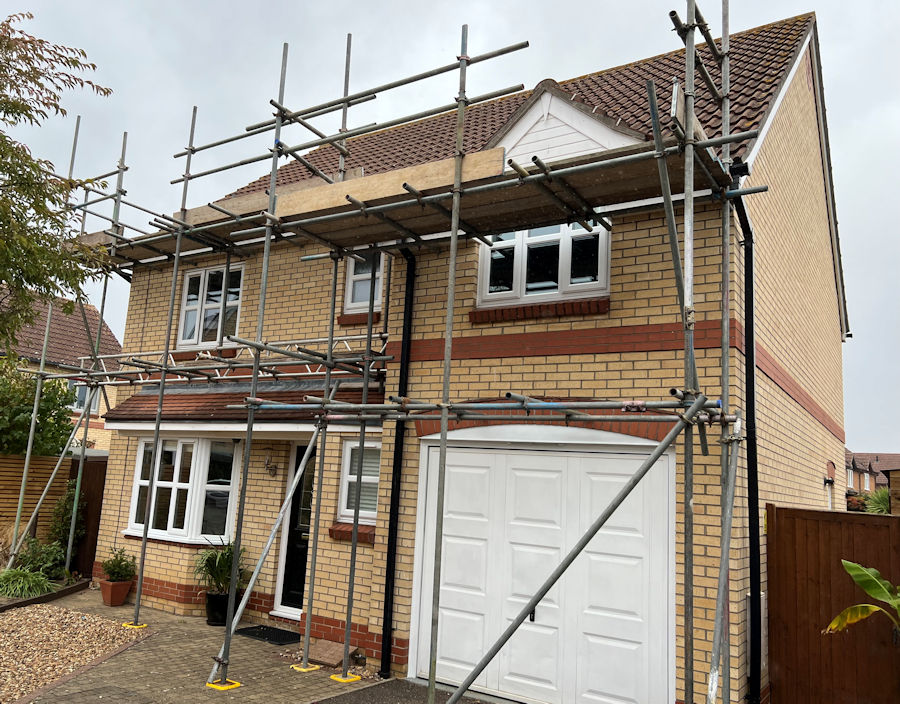
The week before my solar panels were due to be installed, scaffolding was put up on the front of my house.
My installer quoted for 17 Trina 390W panels, giving a total generation capability of 6.63kW. Each panel measures 1873mm × 1030mm.
Microinverters
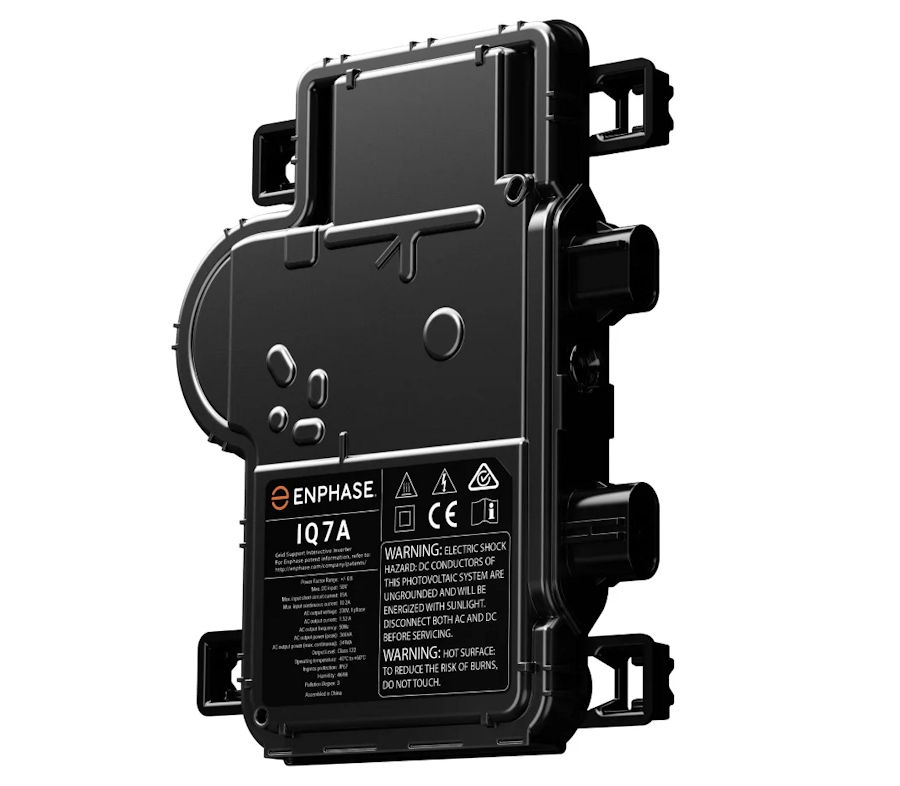
The use of Enphase IQ7A microinverters means that each panel is generating an ac voltage, rather than a dc voltage. It allows each panel to work and be monitored independently using the Enphase IQ Gateway and the Enphase app. This approach also avoids one shaded, damaged or failed panel having an impact on the rest of my generation capability.
My 17 panels with IQ7A inverters will generate a maximum of 5933W. You can read more about why I chose microinverters.
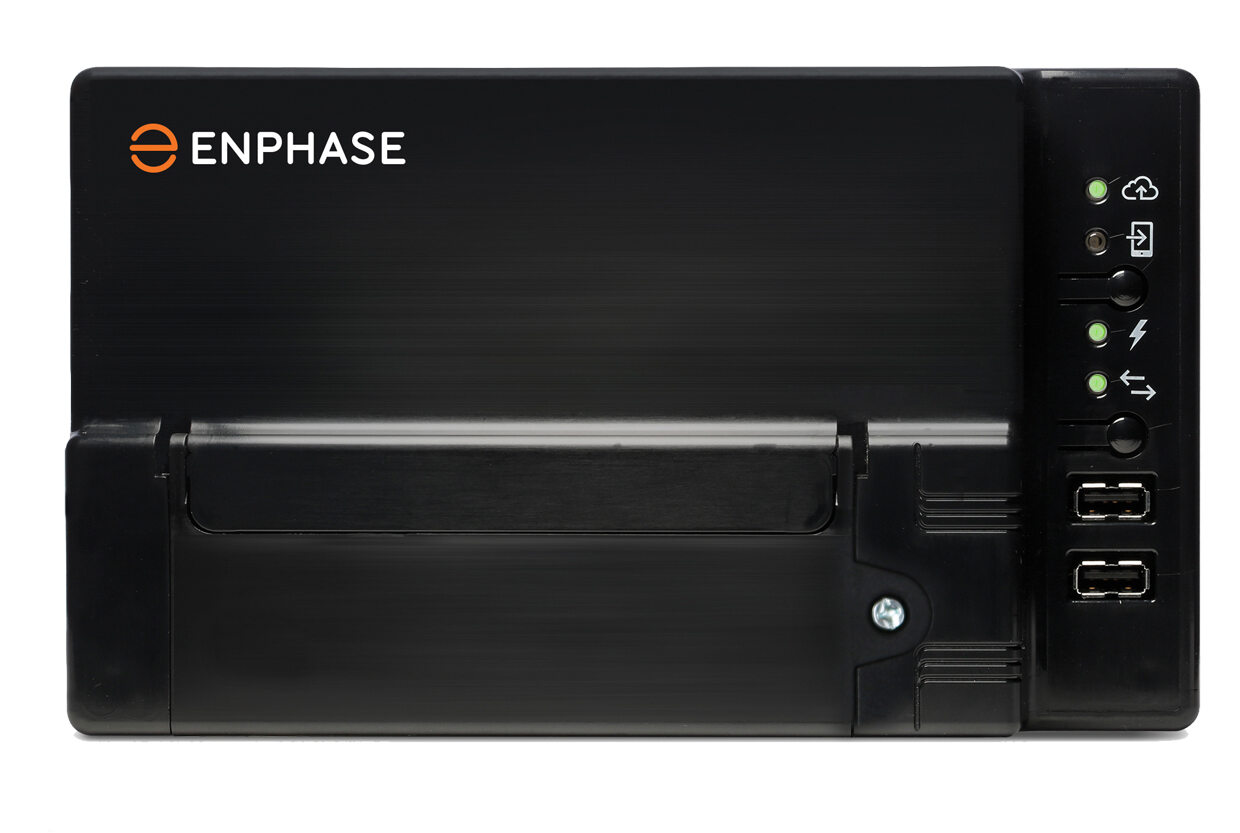
Enphase microinverters are connected to the Enphase Envoy hub, which has a wired Ethernet network interface or it can use Wi-Fi. This allows the Enphase Enlighten app to provide energy usage insights, remote update capabilities and load management.
Tesla Backup Gateway

The Tesla Backup Gateway provides energy management and monitoring for solar self-consumption, time-based control, and backup. The Backup Gateway 2 controls connection to the grid, automatically detecting outages and providing a seamless transition to backup power. The Backup Gateway 2 communicates directly with Powerwall, allowing us to monitor energy use and manage backup energy reserves from any mobile device with the Tesla app. The Tesla Backup Gateway smart home integration is a project in its own right.
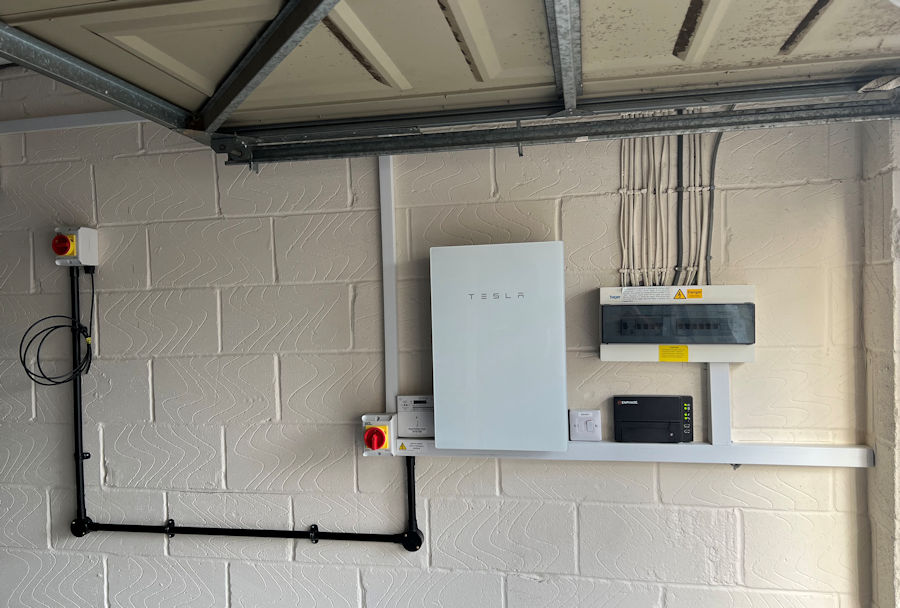
This is the Backup Gateway installed inside my garage. The gap on the wall is for the Powerwall battery.
Tesla Powerwall
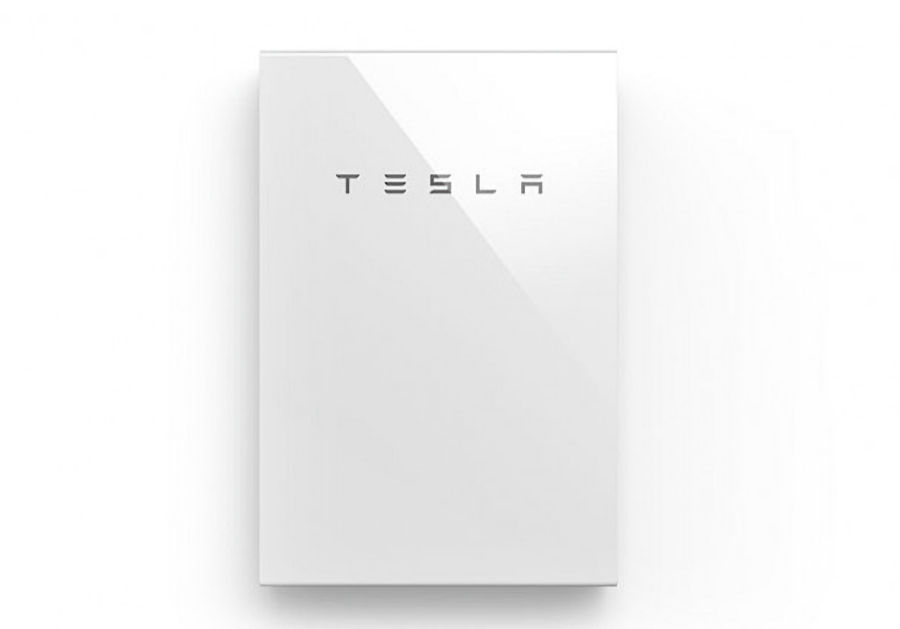
I am installing a Tesla Powerwall battery store with a usable 13.5kW capacity. An important feature of the Powerwall is that it can deliver up to 5kW to our home should it need it. There are many inverters that limit how much power your home can consumer from the solar panels.
The batteries used to store energy will also have a maximum rate at which they can deliver power and be charged. The Powerwall 2 typically charges at up to 5kW, which means it would take less than 3 hours to fully charge, assuming the solar panels are generating this much power.
Despite weighing in at 125kg, my Powerwall is going to have to be wall mounted, so that we can still fit a car in the garage. The powerwall is 1150mm tall × 755mm wide × 155mm deep.
Battery storage pays back quickest when you regularly use the bulk of its capacity all year round. If you select a battery for full winter usage, you will then have a lot of unused battery capacity during the summer.
My Powerwall is going to be mounted on the inside of my garage wall, about 1m off the ground, so that I can still get a car into the garage. The problem with this is that the internal walls of my garage are made of Thermolite blocks and the Tesla Powerwall weighs about 125kg. My solution is to run two steel bars from the ground and up the wall, to carry the weight down to the concrete garage floor. These bars are 40mm wide × 6mm thick and fixed to the wall every 50cm, using 8mm fixings that are bonded deep into the wall. The Powerwall mounting bracket is then fixed to the vertical bars with using four 10mm bolts.
Another advantage of having the Powerwall inside my garage is that the temperatures are fairly constant and never drop below 10°C. The Powerwall actually uses power to keep warm in very cold conditions and hopefully I can avoid this.
EV Charger
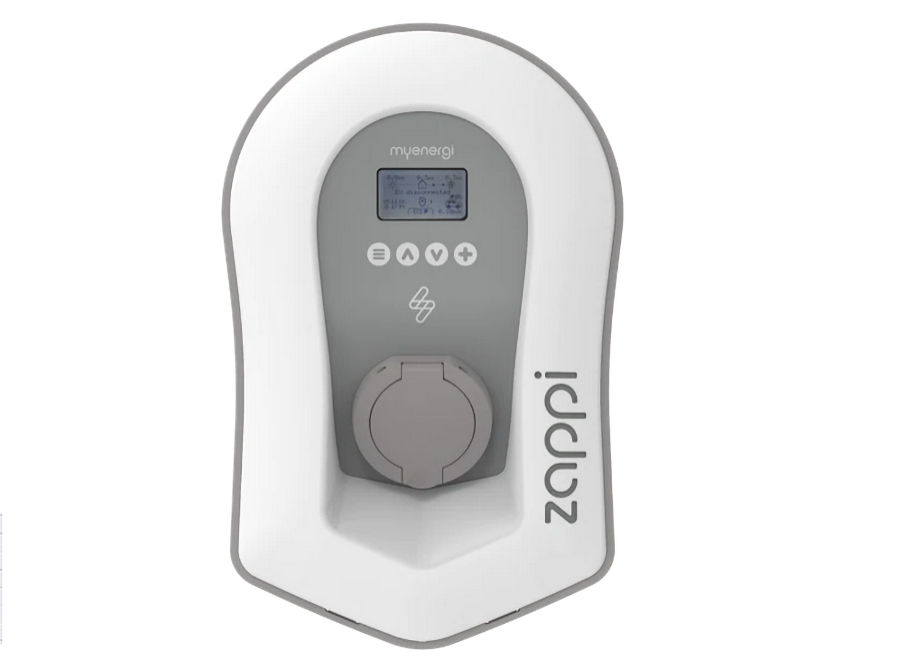
I am installing a Zappi smart EV charger. It is a tethered 6.5m, Type 2 car charger (7kW) and it operates as a standard EV charger, but also has optional charging modes to utilise 100% green energy generated from our Solar PV.
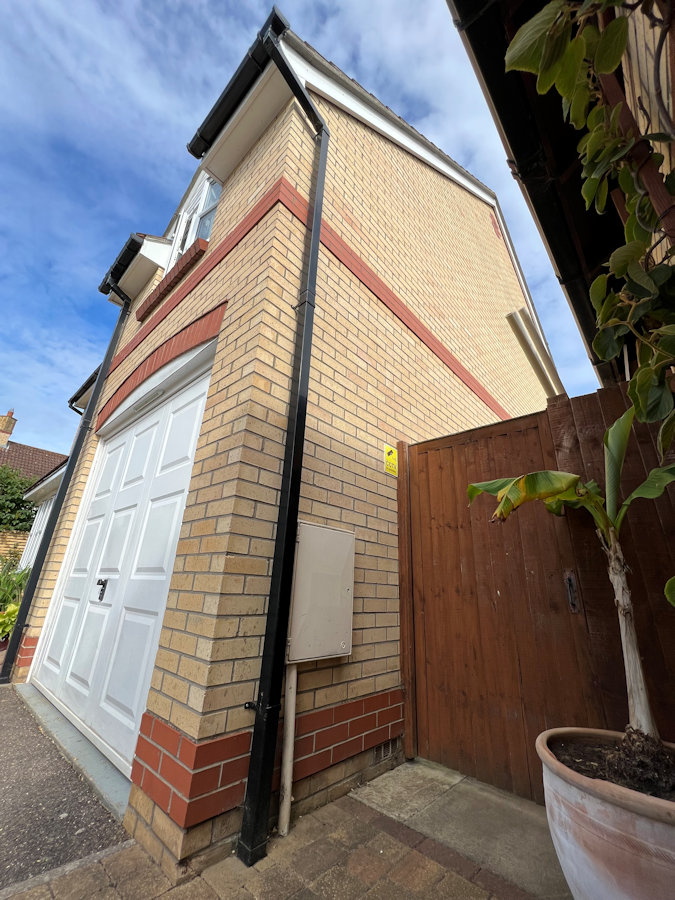
The charger will go on the outside wall of our integrated garage, next to the meter box. The cables will also come out this wall and run up to the loft, hidden behind the drainpipe. This is a wide angle shot taken on my iPhone 13 Pro Max.
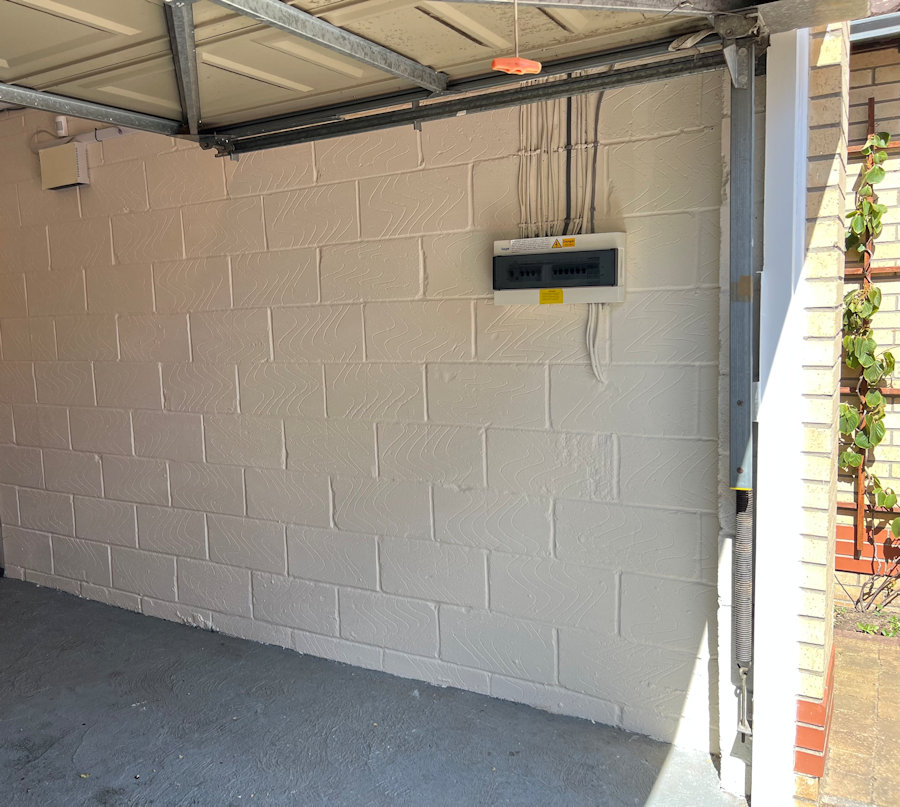
Inside the garage, I have loads of free wall space next to the consumer unit, to mount all the hardware on and expand it later if required. There is enough space for another two Tesla Powerwalls, maybe more. This has all been cleaned and painted, ready for the hardware installation. The gap from the edge of the garage door to this wall is 25cm. A Tesla Powerwall is 16cm deep.
This is an ideal location for this kind of installation. It's never too cold (batteries do not like the cold) and it's never too hot (inverters can fail in high temperatures). It is also secure and protected from the weather.
Smart Home Integration
My contextual smart home already models the many objects that form my Home Control System but, for this project I have had to add support for a new object type, which I have called 'Power'. I have also developed my own Java class and code, as part of my Home Control System, to enable the really intelligent behaviours required. This is covered as a separate energy modelling project.
The key to a high level of integration with my smart home is the APIs provided to access the Tesla hardware and the API to the Zappi EV charger. I'll be documenting this in a lot more detail once the hardware in installed. Not all of these APIs are official.
The Tesla Backup Gateway smart home integration is a project in its own right.
Smart Energy Management Strategy
A 'dumb' solar PV installation with battery storage can save you a lot energy. By connecting it to my contextual smart home, I hope to save much more and also improve our quality of life. Real-time data on generation and usage will allow my Home Control System to smartly control appliances, water heating and Heating, Ventilation & Cooling (HVAC) intelligently, minimising our costs. It will also be able to advise us on the best time to use dumb appliances such as washing machines, tumble dryers, etc. The goal is to avoid importing energy from the power network whenever possible. Generally, I am trying to avoid importing electricity during the peak periods in each day and would like to export as much as possible during this period if I can. The main peak is 4pm to 7pm, when electricity is most expensive and you get the best agile export rate.
This is achieved by monitoring and control, real-time access to data and knowledge of the devices and appliances in our home.This is described in more detail as a separate smart home energy modelling project. I also have a separate smart home energy management project which describes the implementation. I also plan to have an always on energy dashboard on a display, showing exactly what is going on.
Electric Vehicle Charging
I'm assuming my contextual smart home will be able to know what charge state our EV is, whether it is physically connected to the charger and will be able to change the charging mode. The Zappi EV charger can be configured to dynamically use solar PV energy only and to not import power from the grid. This is ideal for us as we don't envisage ever having to fast charge our EV. It could be done if really needed though. We will be exploring the options more, once our charger has been installed.

We have now purchased a CUPRA Born V2 in silver. This car has a 54kWh battery and quoted range of up to 225 miles, enough range to get us to London and back. The plan is that it spends most of its time on our drive (and can therefore be charged). It will be used as a 'pool car' by all four adults in our household. My wife will also use it for her short commute to work (a 10 mile round trip). Occasionally she has to go to Colchester with work (a 52 mile round trip). This means that once charged, it should be able meet all our driving needs for a typical week.
One thing that helps with this planned approach, is that I can also drop her off at work in Ipswich and then the EV can then sit on the drive during the day charging. My wife's workplace charges her to park a car and finding spaces at peak times can be challenging, so this is not as silly as it sounds. For really long trips, we have other ICE vehicles available between us. The premise is that we can essentially charge this EV for free all year round with good planning. If it is not charged, we can take one of the ICE cars as we would currently do.
I have a record of how exactly much we have spent on petrol each month, going back many years. It should be very easy to measure how much less we spend. It's fair to say that some of our ICE vehicles are for fun, so we don't expect our petrol spend to fall to zero. What we save in petrol costs will go some way towards paying for the EV.
Hot Water Pre-Heating
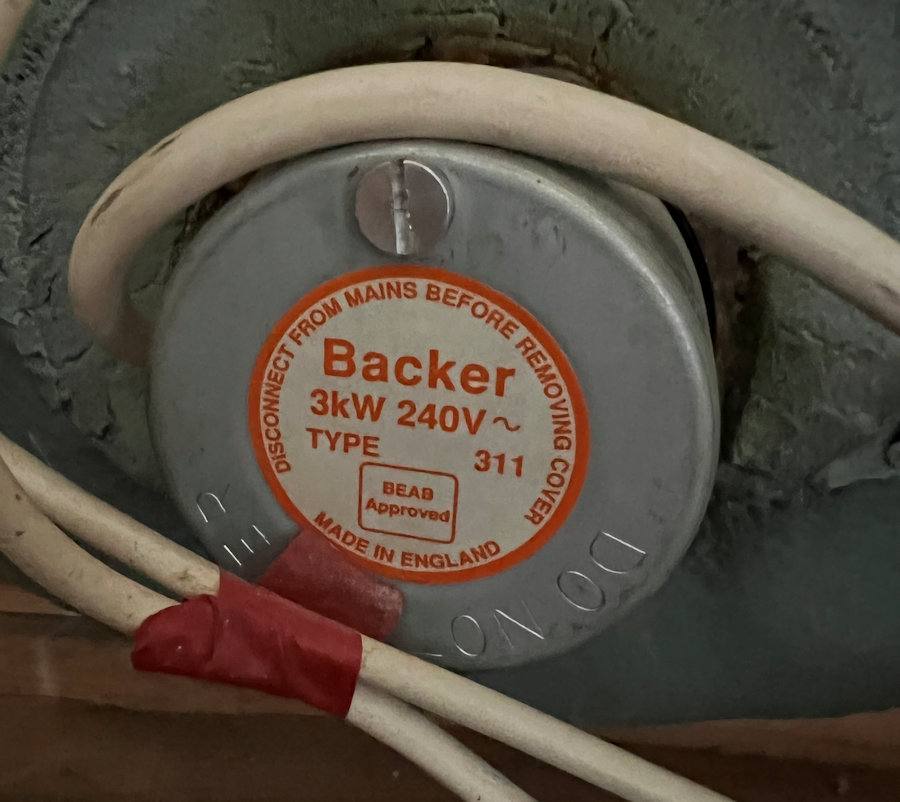
Our current hot water tank already has a (dumb, switched) 3kW immersion heater. Using intelligent control by my contextual smart home, I plan to make this very smart. Using excess electricity to pre-heat the water means we will reduce our gas usage. The really smart element to this though, will be to check the Octopus Outgoing Agile dynamic tariff in real-time, to see if we would be financially better off getting paid for the electricity being produced and using our gas boiler to heat the water instead.
Commercial products to implement this kind of feature use proportional control to vary the voltage to the immersion heater and are therefore able to closely match the load to the spare energy available. I originally planned to use a simpler on/off control mechanism but, having done some testing, I've decided that I need proportional control too. I'm developing my own smart solar immersion heater controller.
Because I have three temperature sensors on my hot water tank, my smart home knows how much hot water is available in real-time. This means it could only heat the tank to a percentage (say 50%) of its capacity if required. It would be very easy to dynamically change our energy management strategy and prioritise based on this figure if required.
My contextual smart home is also making much more intelligent decisions than 3rd party products. It has whole home context and knows about the house status, so it automatically knows if we are in, out or away on holiday. It has real-time access to all of the 400+ sensors and devices in my smart home. It knows how hot the water tank is at any given time, when we will need hot water, the weather forecast, who is at home, etc. This stuff is important because it knows my wife has a bath and that I always have a shower in the morning. The goal of my smart home is to enable intelligent assisted living for all.
Gas Boiler
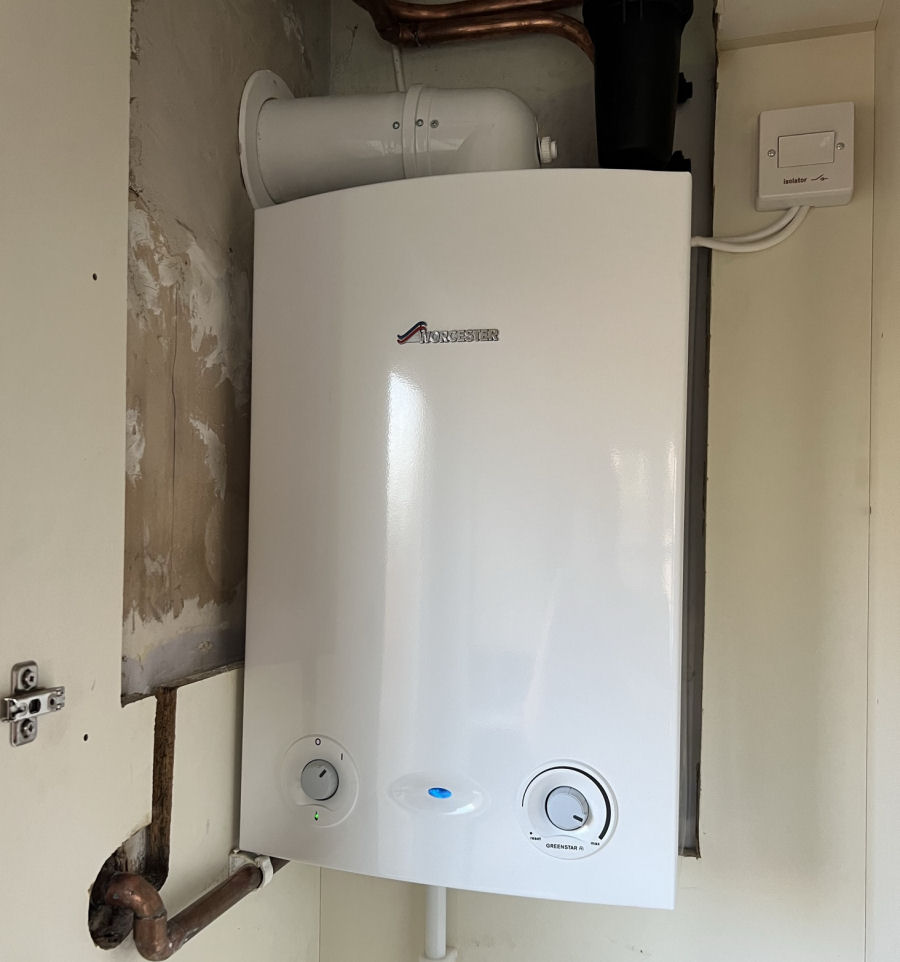
We had a new gas boiler installed in April 2022 and part of that project involved installing sensors to understand exactly how well it is working. A key goal of this project is to minimise its use whenever possible.
Future Updates
Air Conditioning
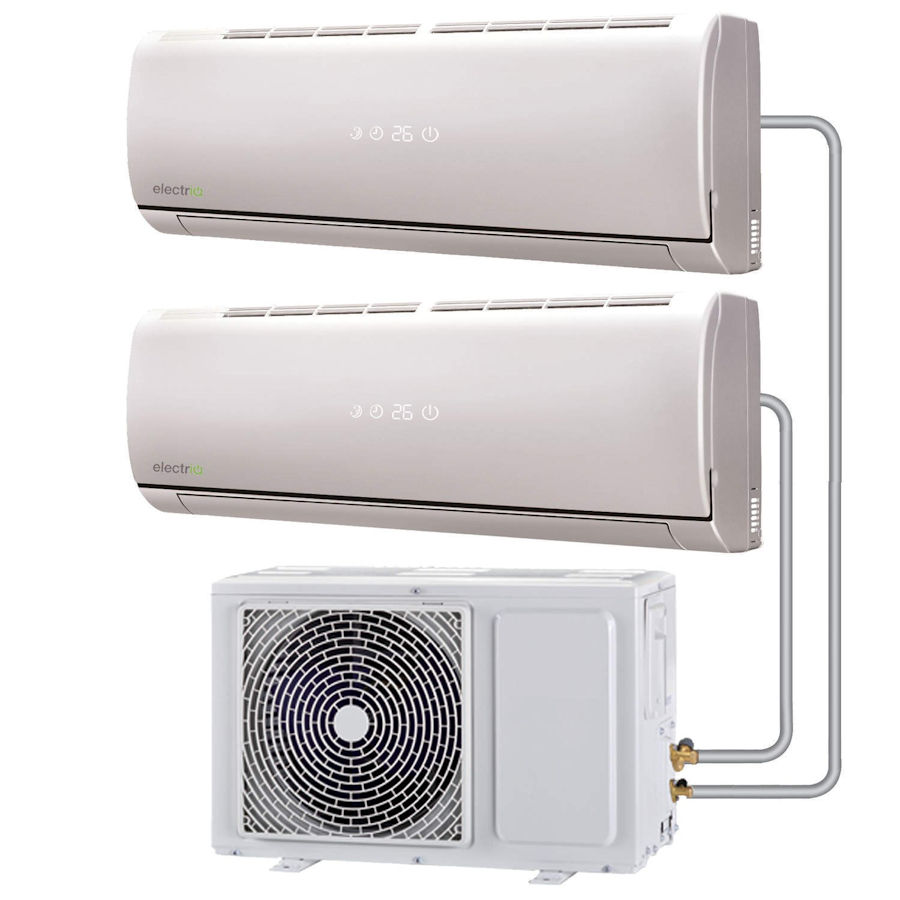
We are not trying to cool our whole home. We are looking to install a split 2-way system, to cool the lounge and main bedroom only. Both are on the same external wall of our house. These things use a lot of power but we only plan to use it on the hottest, sunniest days when we will be generating close to our maximum of 6.63kW.
My preference is for a Panasonic system, purely because I'm familiar with these, having used them in luxury holiday homes, etc. They are also very quiet in operation.
A big factor driving our desire for air conditioning is the impact of climate change and to improve our quality of life. We would like to feel comfortable during the hottest of summer days and also feel safe during the occasional extreme temperatures that we experience here in the UK. These extremes are only getting worse and more frequent. On 15th July 2022, the Met Office issued its first Red Extreme heat warning. This is the first time that temperatures of 40°C have been forecast in the UK.

My @smartest_home occasionally tweets about the (42 as of July 2022) temperature sensors currently installed around our home and garden. The 'Average House Temperature' is a virtual sensor and this is what it looked like at on the 19th July 2022, one of the hottest days ever in the UK. This is why I'd like to install solar powered air conditioning.
Hot Tub
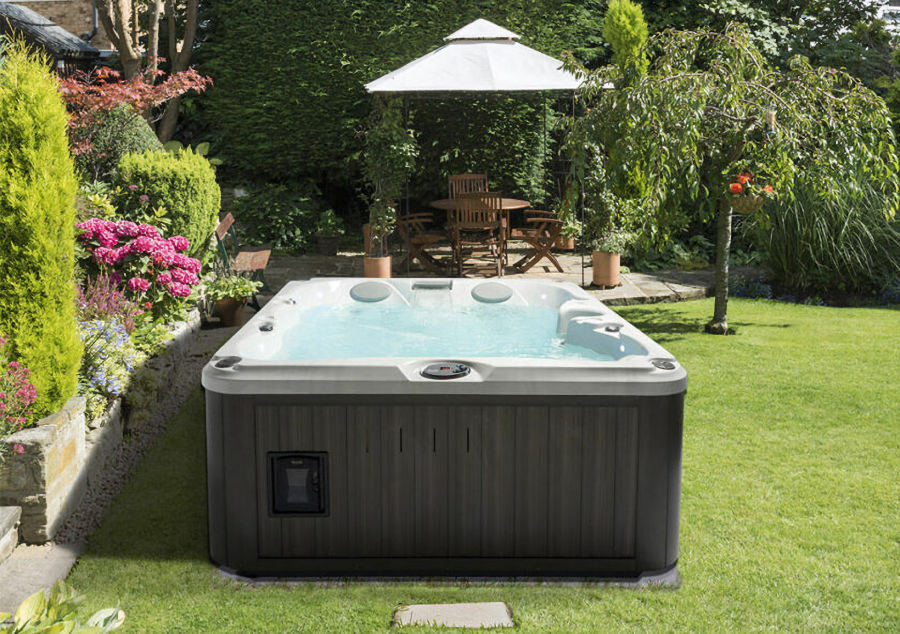
I am currently researching our hot tub project.
Smart Home Installation
Hot Water Pre-Heating
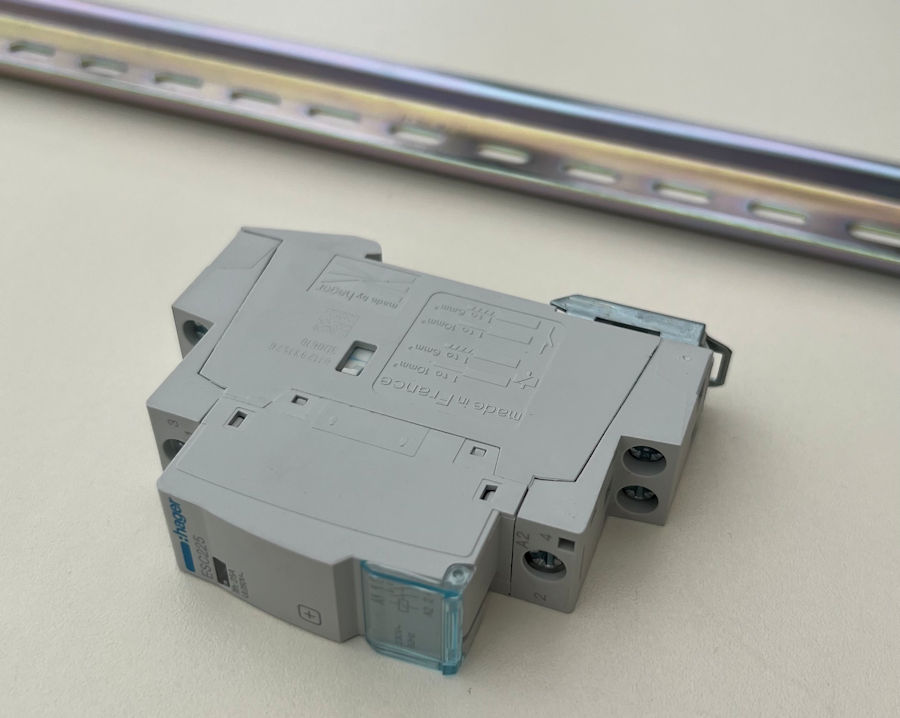
My original plan was to use this Hager ESC225, 25A, 2-pole contactor to safely switch the immersion heater on and off using the Arduino slave processor already installed above our airing cupboard to do the control and reporting. The problem with this approach is that it either uses 3kW or nothing. Having looked at the generation data, there is little time where I need to heat the water and there is 3kW free to do so.
I'm now designing my smart solar immersion heater controller with proportional control, which can put anything from 450W to 3000W into the immersion heater and is fully under the control of my contextual smart home.
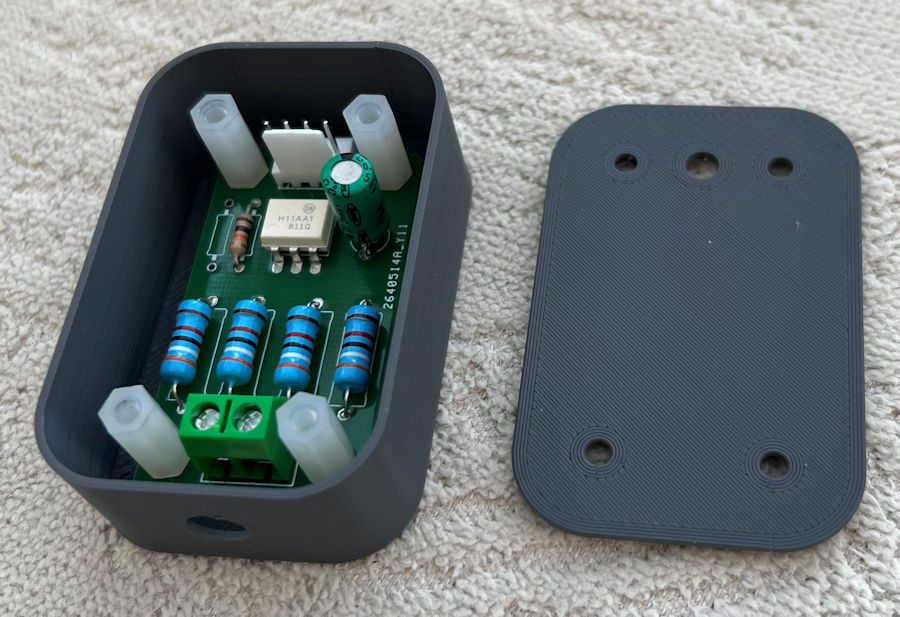
This is the 3D printed the enclosure for my 'Hot Water Demand' sensor, with the sensor board installed.
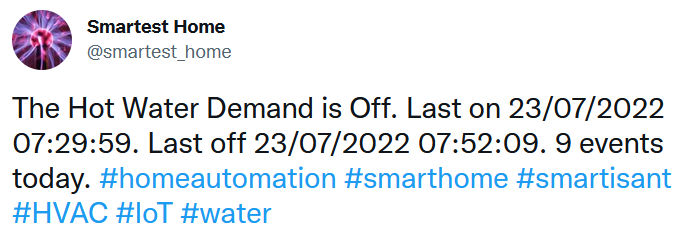
My @smartest_home occasionally tweets about the 'Hot Water Demand'.
Measuring The Benefits
My plan is to measure the benefits of this new installation by comparing how much gas and electricity we use during each month of the year compared to the historical average gas and electricity usage for each month in the year. This should largely negate the effects of annual weather variations, though it doesn't factor in the impact of global warming. Global warming can have both positive and negative impacts on energy usage though. We also had a new gas boiler installed in May 2022, which will have a small positive impact on our gas usage.
This is my baseline data for the average energy (kWh) used for each month of the year up to June 2022:
| Month | Electricity (kWh) | Gas (kWh) |
| January | 528 | 3088 |
| February | 433 | 2041 |
| March | 387 | 2012 |
| April | 392 | 1460 |
| May | 382 | 1029 |
| June | 346 | 512 |
| July | 380 | 509 |
| August | 377 | 514 |
| September | 373 | 619 |
| October | 443 | 1220 |
| November | 486 | 2130 |
| December | 539 | 2784 |
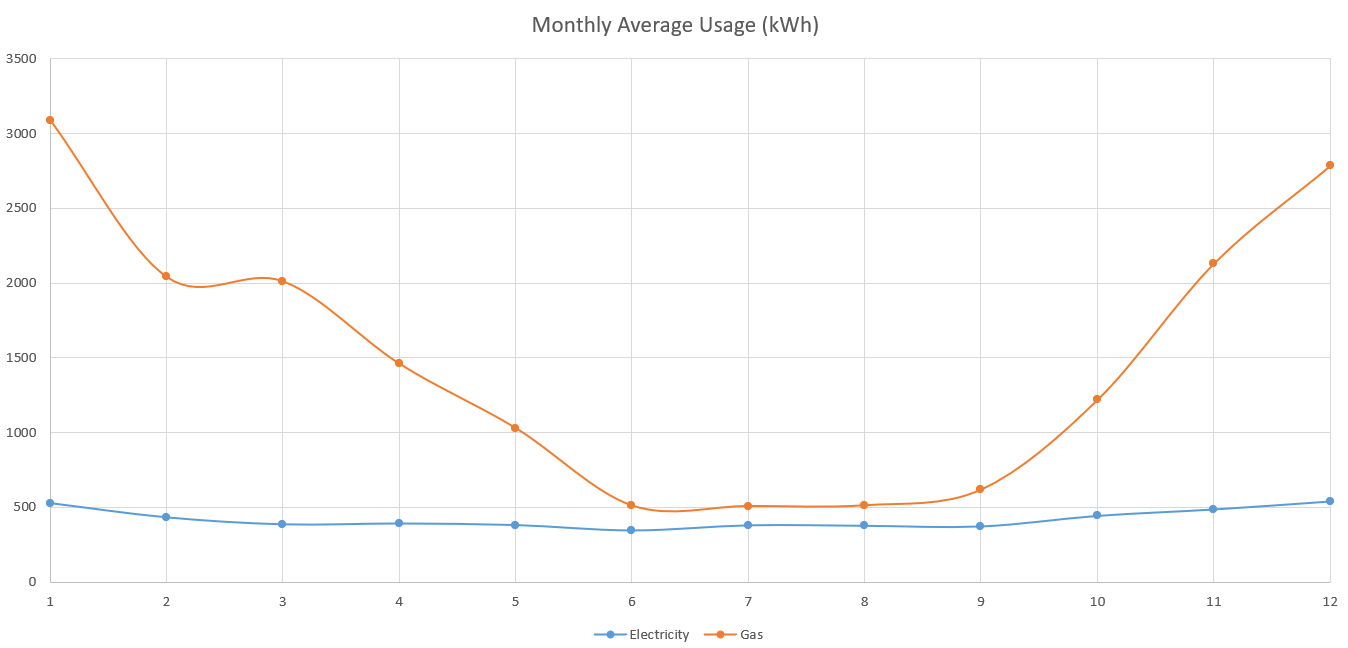
This is what this data looks like plotted out. There are obvious peaks over the winter months. Whilst the electricity usage looks fairly flat the average year, it peaks due to increased use of appliances like our tumble dryer. We also run a dehumidifier over the winter months in our conservatory.
Rather than making this web page even longer with data and graphs, I have a separate page for each year, showing the real, measured benefits and any other useful insight:
Summary & Learning
I've gone for the maximum possible power generation capability we can fit on our roof (6.63kW) and a large (13.5kWh) battery storage, to give us a degree of independence from the local power network. The thinking behind this is that we can keep our home running through power outages and that the frequency of these will only increase. The Tesla Powerwall is not the cheapest option but, it provides good performance, the features and interfaces I require. This project has never been purely about money though.
This project is also an experiment, to see how intelligent smart home control can work with solar power and battery storage technology to optimise efficiency, reduce our costs, whilst improving our quality of life. Much like my contextual smart home, I plan to push the boundaries of what's possible and see just how far the technology can go when intelligently managed by a very smart home.
Roof Inclination
I've been amazed at how much energy we have generated since we had our system installed in September 2022. The fairly steep roof angle of 50° means we capture a lot of the energy from the sun in the winter months, when the sun is lower in the sky. We generated 255kWh in November 2022.
Generation Factor
Someone quoted an interesting solar statistic that I had not seen before. It struck me as a really good measure of location, installation configuration/effectiveness AND the system efficiency. It takes account of your location, the orientation of your panels, any shading, etc. It also takes account of the electrical efficiency of the components installed and any inherent 'over sizing' or 'clipping' and this is something where I'm sure my Enphase microinverters provide a real improvement over traditional inverters.
I've called it the "Monthly Generation Factor" or MGF. Your MGF is the 'monthly generated energy in kWh' divided by the 'specified peak output of your solar panels in kW', for any given month. So for November 2022 my Monthly Generation Factor (MGF) is 255kWh ÷ 6.63kW = 38.5. It does not have any useful units, so I don't use any.
| Year | Jan | Feb | Mar | Apr | May | Jun | Jul | Aug | Sep | Oct | Nov | Dec |
| 2024 | 49.8 | 51.5 | ||||||||||
| 2023 | 46.5 | 64.3 | 66.7 | 130.5 | 138.2 | 152.8 | 126.8 | 130.8 | 114.0 | 76.8 | 53.8 | 25.8 |
| 2022 | 38.5 | 40.0 |
An even better measure is the "yearly generation factor" or YGF. In 2023 we generated 7471kWh, giving a YGF of 1127.
Hot Water Pre-Heating
My hot water demand sensor was fitted and connected up to my contextual smart home before my solar panels were installed and it immediately delivered some more useful insight. With my hot water tank heated up using gas in the morning, it will stay hot until late in the afternoon.
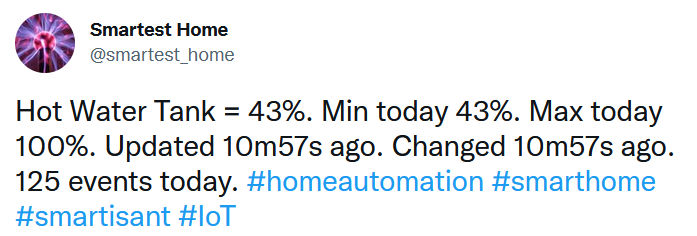
It has also allowed me to more accurately calibrate the percentage of hot water available in our hot water tank. This is useful because my contextual smart home has it's own local artificial intelligence, which we can ask if there is enough hot water for a shower or bath. My @smartest_home occasionally tweets about the 'Hot Water Tank'.
The Environment
You will notice that I have not used the 'environment' word up to this point. That's because I want everyone to recognise the financial and quality of life benefits of this project, without even considering the environmental aspects. You have to be a fool to deny climate change is a real and present threat in 2022 but, even if you are that fool, this project should still make sense to you. For those of us that accept climate change is real, it goes without saying that this project has huge environmental benefits and should massively reduce the amount of carbon monoxide we produce as a family. Climate change is resulting in the UK facing more extreme temperatures and much more frequently.
Our Next Home
I have always planned to design and build our next home and this is the next BIG project I'm currently working on 😎 This solar project has given me the confidence to assume that our next home can be 'off grid'. By combining what I've learnt so far with the imminent advances in battery technology, I think it is now a realistic proposition. It will still require a super-insulated home though, with an advanced heat recovery and ventilation system.
If you found this page useful you can buy me a coffee. This helps me maintain this website and add more content.
Further Reading
My Features
My Projects
- Smart home energy modelling project
- Smart home energy management project
- Enphase Microinverters In My Solar Energy Project
- Tesla Backup Gateway smart home integration project
- My energy data analysis & savings
- AC current transformer sensor
My Reviews
Off-Site Links
If you are considering moving to Octopus, you can use this referral link and Octopus will give us both £50.
- Cost of living: Energy price cap expected to double in January (27/07/2022, Sky News)
- EU energy rationing can't be ruled out, Shell warns (15/07/2022, BBC News)
- France to turn off lights as Macron warns of energy problems ahead (14/07/2022, Independent)
- Cost of living: Energy bills forecast to hit £3,363 a year (09/07/2022, BBC News)




